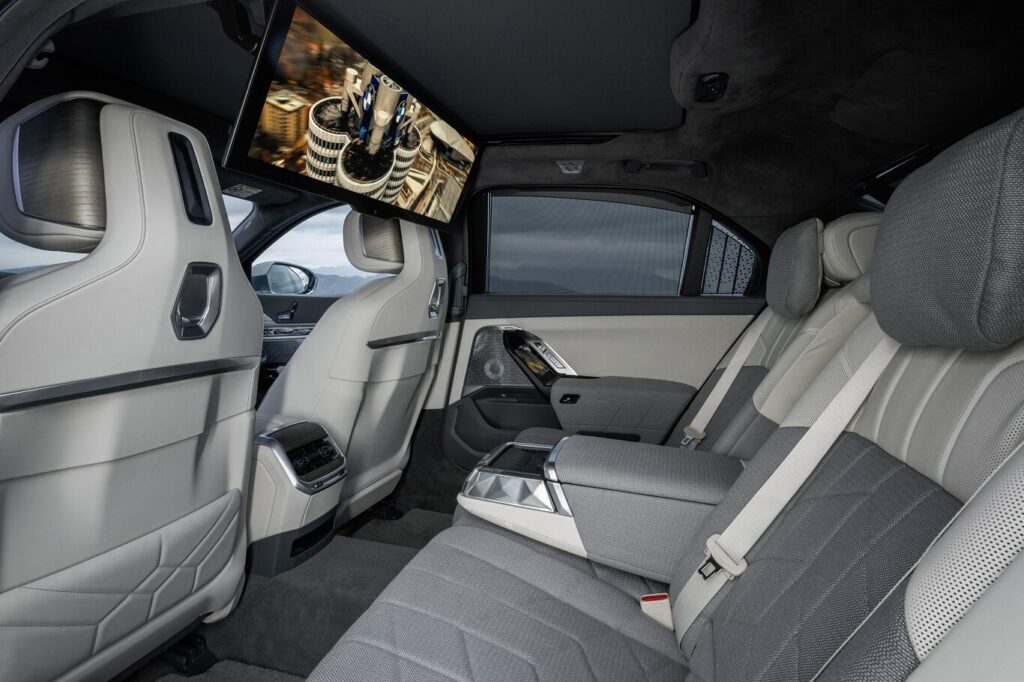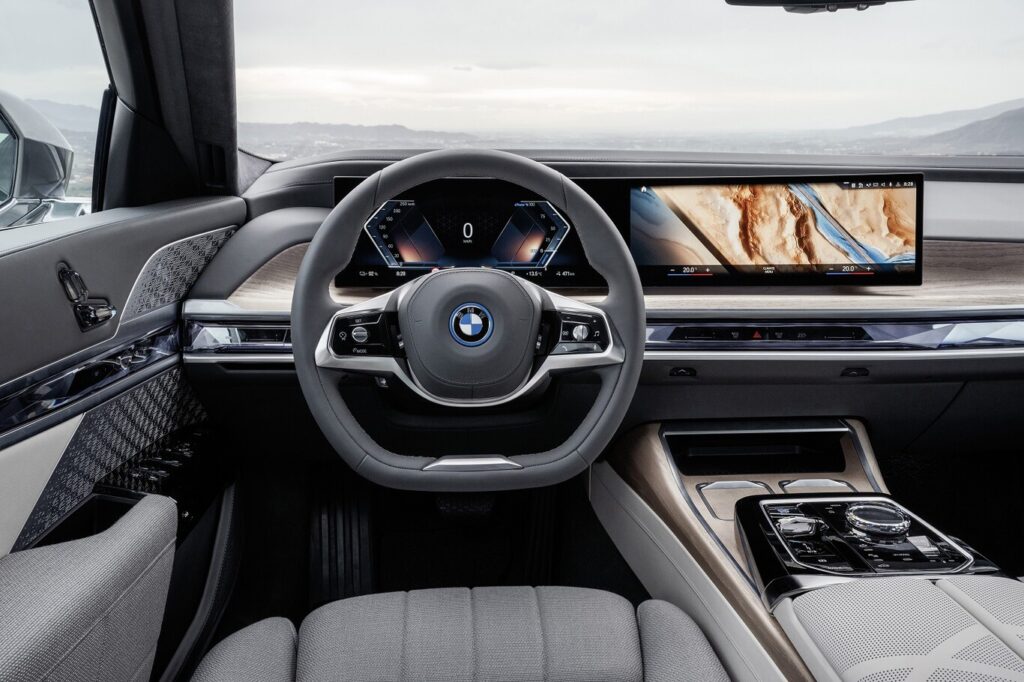BMW’s answer to the Mercedes EQS has already been unveiled. It is called the BMW i7 and arrives as the great electric sedan of the brand. The zero-emission version of the BMW 7 Series has already been presented, with more than 600 kilometers of autonomy, a future M version, and plug-in hybrid options in 2023 with more than 80 kilometers of autonomy.
BMW 7 Series technical specifications
| BMW 7 Series | |
|---|---|
| Body type | Five-seater sedan |
| Measurements and weight | 5,391 mm long, 1,950 mm wide, 1,544 mm high and 3,215 mm wheelbase. 2,150 kg for the BMW i7 xDrive60 |
| Trunk | 500 liters in electric versions |
| Maximum power | 485 kW (660 hp) for the BMW i7 M70 xDrive |
| WLTP consumption | 18.4-19.6 kWh/100 km for the BMW i7 xDrive60. Consumption of 1.2 – 1.1 l/100 km for the BMW M760e xDrive. |
| DGT environmental label | C and Zero emissions |
| Driving aids (ADAS) | Adaptive Cruise Control, Emergency Braking, Lane Guidance Assist, Level 3 Parking Systems, Cross-Traffic Alert. |
| Others | 14.9-inch central screen, 12.3-inch instrument panel, and 31.3-inch rear screen, touch screen, and 8K resolution. Bowers & Wilkins surround sound system. Own operating system with wireless updates. |
| electric hybrid | No |
| Plug-in hybrid | Yes. The total combined output of 420 kW (571 hp) for the BMW M760e xDrive and 490 hp for the BMW 750e xDrive. Both with autonomies greater than 80 kilometers. |
| Electric | Yes. Two engines with a combined power of 400 kW (544 hp) in its BMW i7 xDrive60 version. BMW i7 M70 xDrive with a total output of 485 kW (660 hp). |
| Price and launch | Launch in late 2022 for the BMW i7 xDrive60 and throughout 2023 for the BMW i7 M70 xDrive and plug-in hybrid versions. |
A more conservative offer
It is impossible to talk about the new BMW 7 Series (BMW i7 in its all-electric version) without looking sideways at the Mercedes EQS. Two of the most luxurious sedans on the market already have their all-electric versions but taking different paths. If Mercedes has chosen to frame the electric S-Class within a family of its own, BMW chooses to offer the i7 as another version within the new 7 Series, although encompassed in its all-electric i family. Curiously, BMW has been the most conservative.
Because the BMW 7 Series will have combustion, plug-in hybrid, and electric versions. And because the cabin is committed to refinement, the best materials but also a much more conservative layout than the groundbreaking BMW iX. Those looking for a model completely different from any other model within the Bavarian brand will have to choose the SUV format.
The mechanicals of the BMW 7 Series will be shaped as follows:
- BMW i7: the electric version will be available for everyone.
- BMW 7 Series PHEV: the plug-in hybridization will arrive throughout 2023 for the whole world.
- BMW 7 Series combustion: A diesel engine will arrive in Europe. Eight- and six-cylinder gasoline engines will also arrive in the United States, China, and other selected markets.
The decision is undoubtedly a reflection of the European Union’s environmental policies and its stringent CO2 limits. Nevertheless, BMW will continue to focus on pure combustion engines, as it announced a few months ago, and follows the line offered by Thierry Breton, EU Commissioner for the Internal Market, who encouraged manufacturers to market these engines outside the EU borders.
BMW 7 Series, the best is on the inside
One way or another, it is clear that the move towards electrification of the large German saloon has no way back, especially in the European market. Here, the BMW i7 will arrive at first with the name xDrive 60, which will mount an engine of 400 kW (544 hp), a battery with 101.7 kWh net capacity, and homologating a range of between 590 and 625 kilometers. For charging, it will support powers of up to 195 kW.
Later we will see an even more powerful option with the name of the BMW i7 M70 xDrive, which will become the flagship, although we will have to wait to know more details of its mechanics. These zero-emission mechanics will be accompanied by plug-in hybridization. The BMW 750e xDrive will deliver up to 490 hp and the M760e xDrive will go up to 571 hp. In both cases, the ranges will exceed 80 kilometers, as the German government was expected to require in the future to qualify for subsidies.

Although, undoubtedly, what is most surprising about this new BMW 7 Series is its BMW Theatre. A 31.3-inch widescreen touchscreen in 32:9 format with 8K resolution, Bowers & Wilkins surround sound system with speakers integrated into the headrests and subwoofers in the backrests as an option. A whole experiential space for rear passengers, who are the center of attention in this type of sedan.
The driver will have a 12.3-inch instrument panel and a 14.9-inch central infotainment screen on a single glass surface curved towards the driver. An arrangement that we already saw in the BMW iX. The steering wheel, however, opts for rounded shapes and leaves aside the hexagon that we also tested in the SUV. These screens are accompanied by the so-called Interaction Bar that groups the ambient light, decorative elements, operating functions, or the air outlets of the climate control in a single piece.
It also debuts the new BMW iDrive operating system (compatible with Android Auto and Apple CarPlay), with the ability to be controlled from the rear seats through 5.5-inch screens located in the doors. It is accompanied by four interior ambiances, video-on-demand streaming, and YouTube integration with the central infotainment screen. The driver will enjoy navigation with augmented reality on the central screen and a Head-Up Display with renewed graphics.

The infotainment section closes its remote updates, the individualized user experience with your BMW ID, and the ability to take pictures with an interior camera that can also send images to your cell phone.
In terms of driving aids and safety, the BMW 7 Series will have level 3 automation and parking systems, those that in the future will allow driving without the need for the driver to be paying attention to what is happening around him.
As for ADAS systems, adaptive cruise control with emergency braking and forward collision warning with detection of approaching vehicles when making a left turn and nearby pedestrians and cyclists in a right turn are included. Lane guidance assistant, maneuvering assistant, automatic speed limit assistant, or route control and traffic light recognition can be included.
This post may contain affiliate links, which means that I may receive a commission if you make a purchase using these links. As an Amazon Associate, I earn from qualifying purchases.

